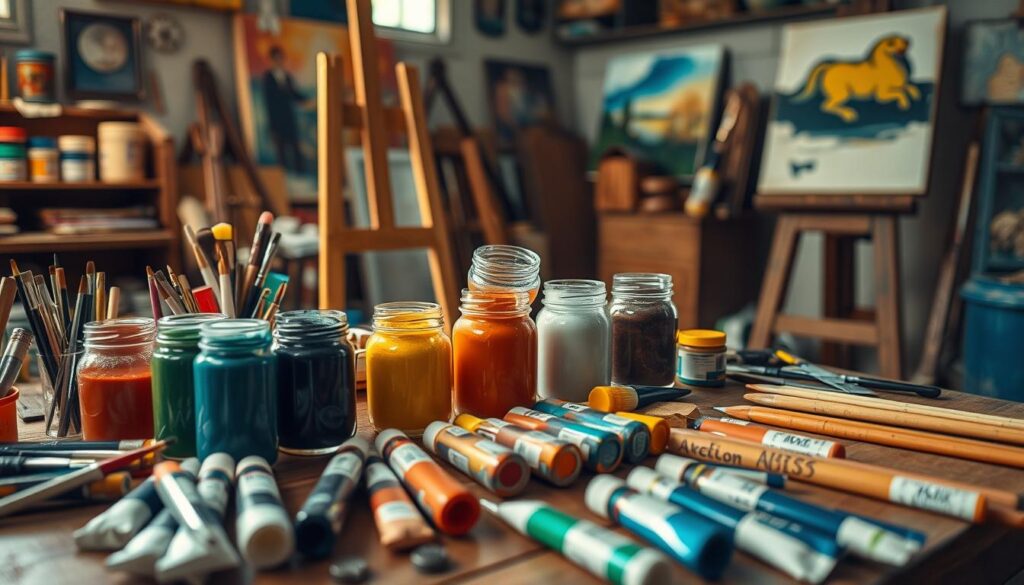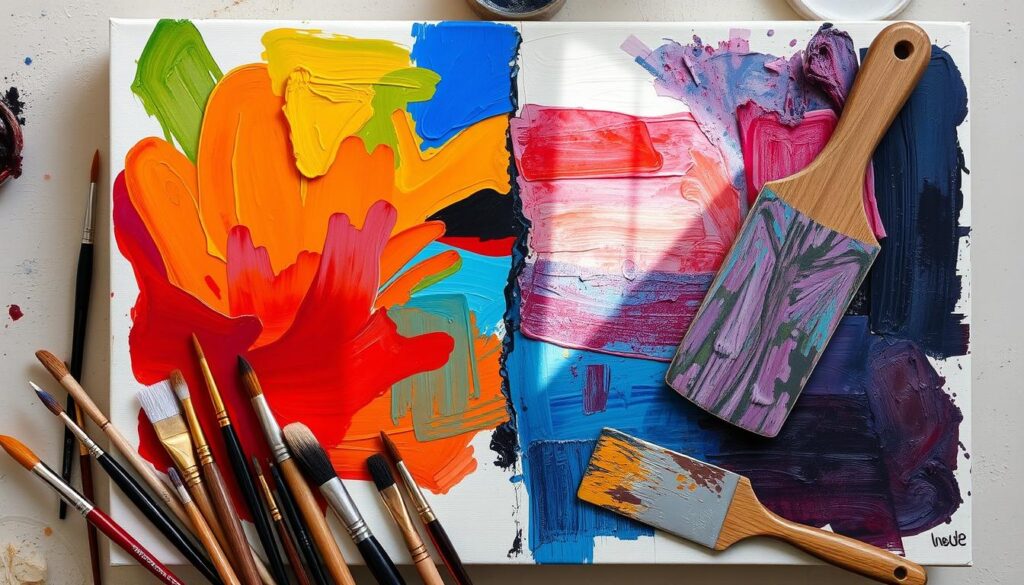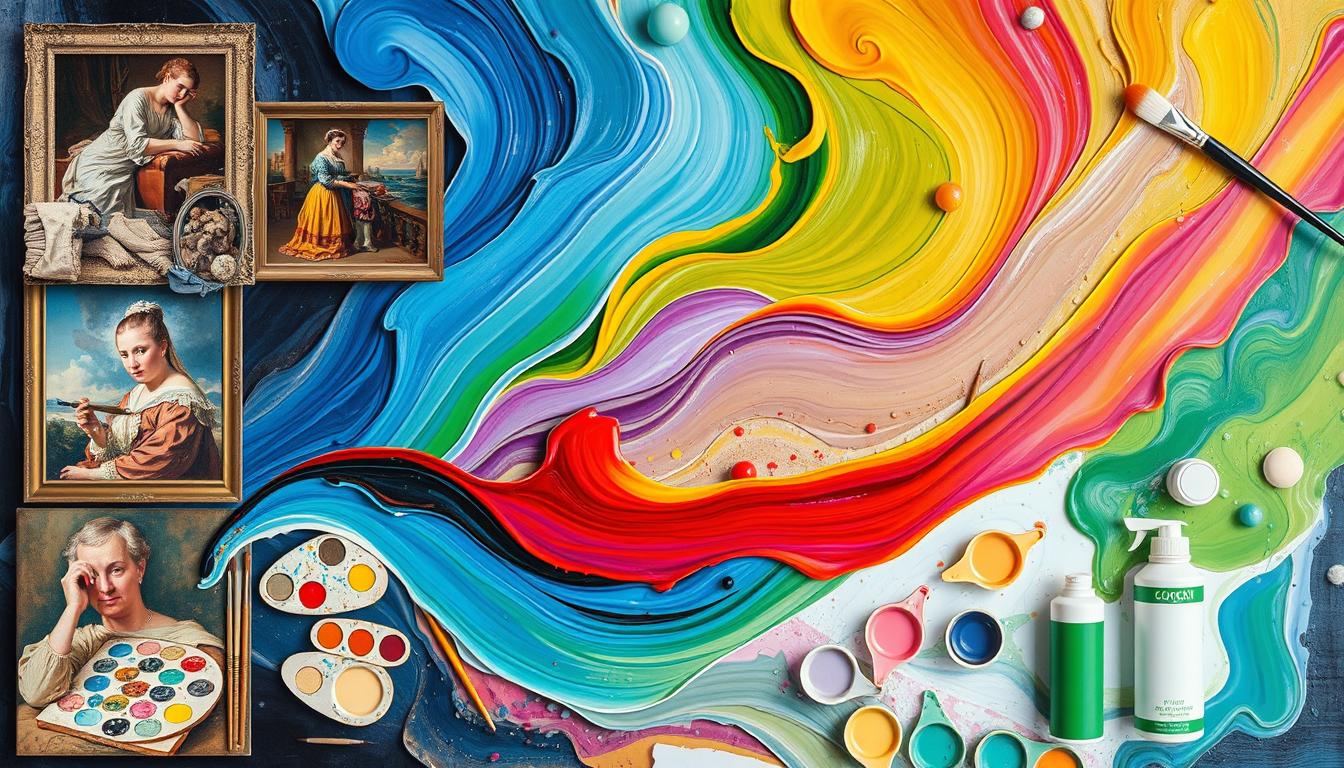This post contains affiliate links.
Imagine you’re standing before a canvas full of life and color. Suddenly, you’re taken back to when the art world changed forever. This was thanks to acrylic paint. The journey of acrylic painting began with innovators in the 1930s. It involved German chemist Otto Röhm and the Röhm und Haas Company. This adventure has turned acrylic painting into a key part of modern art.
Jump to the 1950s, when a company called Liquitex introduced water-based acrylic paints. These paints dried quickly, changing the game for artists. They weren’t held back by the slow drying of oils anymore. Now, artists could work faster and try new techniques easily.
This change wasn’t just about speed. It also helped start big movements in art. Artists like Andy Warhol and David Hockney chose acrylics for their bold works. Whether used for powerful protest art or stunning murals, acrylics helped share important messages worldwide.
Key Takeaways
- Acrylic paints were first developed in Germany in the 1930s.
- The introduction of water-based acrylics by Liquitex in the 1950s transformed the art scene.
- Acrylics dry quickly, offering a faster alternative to traditional oil paints.
- Renowned artists like Andy Warhol and David Hockney embraced acrylics for their versatility.
- Acrylics played a significant role in socio-political art movements and global cultural expressions.
The Birth of Acrylic Paint
Acrylic paint began in Germany in the 1930s. The first acrylic resin dispersion was a big step forward. It led to modern acrylic paints, known for their special qualities and wide use in art.
Origins in Germany During the 1930s
In the 1930s, a key discovery changed art forever. BASF, a German chemical company, made the first acrylic resin in 1934. This started acrylic paint’s journey, leading to its growth and popularity later on.
By the 1940s, people used acrylic emulsions for house painting. They liked its ease of use, quick drying, and safer ingredients.
Innovations by Otto Röhm and the Röhm und Haas Company
Otto Röhm’s work was vital to acrylic paint’s evolution. As a German chemist, his research on acrylic acid was crucial. He founded Röhm und Haas with Otto Haas. In 1934, they got a patent for acrylic resin, setting the stage for art materials to come.
Otto Röhm and Röhm und Haas’s invention led to acrylic paints as we know them. Known for drying fast and being waterproof, their work changed art materials forever.
| Timeline | Milestones |
|---|---|
| 1934 | First usable acrylic resin dispersion developed by BASF |
| 1940s | Acrylic emulsions gain popularity for home painting due to their practicality |
| 1955 | Permanent Pigment Company develops water-based acrylic gesso, named Liquitex |
| 1953 | Politec Company in Mexico supplies water-based acrylics to Mexican Muralists |
| 1960s | David Hockney uses acrylic paints for notable works |
| 1970s | Acrylic paint gains popularity among artists for its fast drying properties |
Early Commercialization Efforts
The early days of acrylic paints were groundbreaking. In 1947, Leonard Bocour and Sam Golden worked with Röhm und Haas. They created an artist-grade acrylic paint named Magna. It was loved for its fast drying time and flexibility, changing how artists worked.

Leonard Bocour and Sam Golden’s Contributions
Leonard Bocour and Sam Golden were key to making acrylic paints popular. Besides Magna, they introduced a spirit-based paint in 1949. Their continuous efforts made acrylics essential for artists.
The Launch of Magna and Aquatec
After Magna‘s success, the company launched Aquatec in 1955. This water-based paint was safer and easier for artists. It was a big moment in acrylic paint history, allowing artists to try new styles.
The Rise of Water-Based Acrylics
Water-based acrylics brought a big change in art and material science. They offered artists ease and flexibility. This was a key step in the acrylic paints’ growth.
The Introduction of Liquitex in 1955
In 1955, the Permanent Pigment Company introduced Liquitex. It was a game changer for artists. Liquitex made acrylic paints easier to use, with quick drying times and simple cleanup. It blended oil paint’s flexibility with the easy use of water-soluble paints.
The Development of Fluid Acrylics
A year later, in 1956, fluid acrylics came into play. They brought more versatility and allowed for smooth application and detailed work. The introduction of fluid acrylics increased the popularity of water-based acrylics among artists. Their flexibility and adaptability made acrylics an essential part of modern art.
| Feature | Water-Based Acrylics |
|---|---|
| Drying Time | Quick, often within minutes |
| Cleanup | Easy, requires only water |
| Use | Suitable for various techniques due to fluidity and versatility |
| Health and Environment | Eliminates the need for harmful solvents, making them more environmentally friendly |
Comparing Acrylic Paint to Traditional Oils
When comparing acrylic and oil paint, there’s a big difference in drying time. Acrylics dry fast, in about 10 minutes to an hour. Oils, however, can take up to weeks. This means artists who use acrylics can work faster and add layers without waiting long.

Another plus for acrylics is that they’re less toxic and easier to clean. You don’t need harsh chemicals like turpentine, just water. This makes acrylic painting safer for your health and better for the environment.
Oils keep their color the same, wet or dry. Acrylics, though, get a bit darker when they dry. But, acrylics won’t yellow or fade as much over time. They stay vibrant longer. Oils are great for blending colors smoothly, but acrylics are perfect for sharp lines and modern art.
Today, new acrylic products can act like oils but dry faster. Acrylics can be both thin like watercolor and thick for 3D effects. Artists can try different styles with acrylics, making them very flexible.
Choosing between acrylics and oils depends on what an artist needs. If you like working quickly and safely, and enjoy experimenting, acrylics might be for you. Both have their benefits, so it’s about what works best for each person.
The Role of Science in Acrylic Paint Evolution
The evolution of acrylic paint is closely tied to the mix of art and chemical engineering. This mix has changed how artists express their creativity. The blend of science and art has made paints more vibrant and long-lasting. It proves science’s key role in advancing the art world.
The Intersection of Art and Chemical Engineering
Art and chemical engineering work together closely. Acrylic paints were born in the 1940s, thanks to chemistry. Key ingredients like ethyl acetate and xylene were crucial. Chemists’ work on polymers led to faster-drying resins and more color options.
Collaborations Between Artists and Chemists
Artist chemist collaborations have changed modern acrylics. These teams improved how paints are made. Techniques like high-speed pigment dispersing and sand mills evolved. Historical pigments such as ultramarine have inspired ongoing art-chemistry unions. These efforts have brought about groundbreaking colors like YInMn Blue and super-black pigments.
These efforts show how various chemicals and elements play their part in paint making:
| Component | Usage |
|---|---|
| Pigments | Impart color to materials |
| Water | Carrier for latex paints |
| Petroleum distillates | Used in alkyd paints |
| Titanium Dioxide | Creates opacity |
| Barium Sulfate | Provides density and glossiness |
This partnership and scientific method have lifted modern acrylics. It underlines the crucial role of artist chemist collaborations in acrylic paint’s progress and improvement.
Popular Techniques in Acrylic Painting
Since the mid-20th century, acrylic paints have changed the art scene. They dry fast and are super versatile. Let’s look at some top acrylic painting techniques artists use, such as layering, wash and glazing, and impasto.
Layering for Depth and Texture
Acrylics dry quickly, making layering easy and effective. This method lets artists create depth and detail. They can add layers to build a narrative or show history in their artwork.
Artists like Kimberley Kermode use layers to talk about culture and history. Her pieces show complex stories about cultural identity. You can learn how acrylics help tell stories about culture and history by reading this detailed article.
Wash and Glazing Techniques
With acrylic painting techniques, artists can imitate watercolor looks. Wash and glazing add a light, see-through paint layer. This creates brightness and depth.
These methods are great for showing light and shadow. They make the artwork’s story richer and more engaging.
Impasto and Textural Variations
The Impasto method applies paint thickly for a 3D effect. This, along with acrylics drying fast, lets artists create texture quickly. It adds an exciting look and feel to paintings.
Using impasto with layering and washing and glazing lets artists experiment with new texture and depth. It’s a way to push the limits of creativity.
Acrylic paints appeared in the 1930s and got popular in the 1950s, thanks to brands like Liquitex. They let artists try new things with texture and depth. That’s why famous artists like David Hockney and Helen Frankenthaler love using acrylics. They keep finding new ways to use these flexible paints.
Notable Artists and Their Acrylic Masterpieces
Acrylic paint dries quickly and is very versatile. This has made it a favorite for many famous artists. Andy Warhol, David Hockney, and Roy Lichtenstein are celebrated for their innovative artwork. They used acrylics to make some of the most influential pieces in modern art.
Andy Warhol’s Contributions
Andy Warhol played a key role in the Pop Art Movement using acrylic paint. His iconic works, “Marilyn Diptych” (1962) and “Campbell Soup Cans” (1962), use bright colors and repetition. They make statements about mass production and consumer culture. Warhol’s art shows how bold and versatile acrylics can be.
David Hockney’s Innovative Use of Acrylics
David Hockney is another pivotal figure in the acrylic art world. His “A Bigger Splash” (1967) displays incredible depth and bright colors, highlighting acrylic’s unique qualities. He expertly used acrylics for clear lines and rich colors, as seen in “Portrait of an Artist (Pool with Two Figures)” (1972). Hockney’s work has greatly influenced how artists use acrylic paint today.
Roy Lichtenstein’s Bold Artworks
Roy Lichtenstein added a new layer to acrylic art with his comic-book style. His works like “Whaam!” (1963) and “Drowning Girl” (1963) show strong, graphic designs and careful details. Lichenstein celebrated acrylic paint’s flexibility. His innovative style has inspired many artists to experiment with acrylics.
Together, these artists showed that acrylic paint can go beyond traditional limits. They didn’t just change the medium; they also impacted major art movements. Their groundbreaking art continues to motivate both well-known and upcoming artists. This confirms acrylic paint’s key role in contemporary art.
Impact of Acrylic Paint on Contemporary Art
Acrylic paint arrived in the mid-20th century and changed art forever. It brought new techniques and styles to painting. Fast drying times, versatility, and easy cleanup made it popular among artists. This innovation opened doors to new artistic movements and experiments.
Influence on the Pop Art Movement
The Pop Art movement in the 1960s thrived with acrylic paints. Artists like Andy Warhol and Roy Lichtenstein loved its bright, unchanging colors. Acrylics helped create the iconic, bold visuals of Pop Art. Works like Warhol’s prints and Lichtenstein’s motifs became famous thanks to acrylic paint.
Role in Socio-Political Art Movements
Acrylic paint has also made waves in socio-political art. Its boldness and accessibility were perfect for protest art and murals. It became key in movements for civil rights, peace, and feminist issues. Artists chose it for murals and banners that delivered strong societal comments.
David Alfaro Siqueiros used acrylics for their flexibility in making large, impactful works. His creations addressed contemporary socio-political issues vividly.
Integration of Acrylics in Global Art Narratives
Acrylic paints are known for being versatile and colorful. They have become a key part of art around the world. Their fast drying time lets artists layer and create textures easily. This has led to a wide adoption of acrylics. They play a big role in mixing cultures and expressing ideas.
Adoption by Diverse Cultures
Acrylics are used in art scenes from Asia to African traditions. For example, Indigenous Australian artists use them for updated dot paintings. This approach keeps old stories alive for today’s viewers. It’s a perfect example of art bringing cultures together.
Fusion with Traditional Art Forms
Acrylics fit right into old art traditions, too. They’ve mixed into art with deep roots in various places. For example:
- Indian artists blend acrylics with Madhubani painting designs.
- Japanese artists merge acrylics with Sumi-e techniques.
- Mexican artists add acrylics to colorful, folklore murals.
These fusions keep traditions going while starting new art forms. Artworks from around the globe show how acrylics help artists join forces. They link tradition with innovation, making a worldwide art community.
| Artist | Artwork | Medium | Year |
|---|---|---|---|
| Bee Malka | Don’t be so Blind | Acrylic and pen on canvas | 2022 |
| Lucy Getting | Flossy | Acrylic on canvas | 2024 |
| Rebecca Bright | Whatever Happened to Fray Wray? | Acrylic paint on paper | 2022 |
| Anvita Bakshi | Krishna Pichwai Art | Acrylic paint, modeling paste, and pen on canvas | 2023 |
Environmental and Health Benefits of Acrylics
Artists began choosing acrylic paints over oils for more than artistic reasons. This choice supported global environmental and health consciousness. Acrylics are a sustainable option. They have non-toxic solvents, clean up easily with water, and produce fewer harmful fumes.
Acrylics dry quickly. This lets artists work fast and use less resources. Once dry, they’re water-resistant and don’t yellow or crack easily. This makes art last longer and supports sustainable art by needing fewer repairs.
Acrylics are safer than traditional oil paints. They don’t need harsh chemicals for cleaning, just water. This makes them more accessible and healthier for artists to use.
New eco-friendly acrylic paints are being made. They reduce microplastic release and have recyclable packaging. These innovations help artists combine creativity with sustainability.
Explore more about acrylic painting tips.
Let’s look at how acrylic paints differ from oil paints:
| Feature | Acrylic Paints | Oil Paints |
|---|---|---|
| Drying Time | Minutes to a few hours | Days to weeks |
| Durability | Water-resistant and crack-resistant | Prone to yellowing and cracking |
| Cleanup | Water only | Requires solvents |
| Health and Safety | Non-toxic solvents | Hazardous chemicals |
| Sustainability | Eco-friendly options available | Requires careful waste management |
The benefits of acrylics make them popular among artists today. They allow for both creative expression and a safer, eco-friendly art process.
History of Acrylic Painting
The story of acrylic painting began with important moments that changed its course. In 1934, BASF created the first usable acrylic resin. This marked the start of synthetic paints. By the 1950s, pioneers like Leonard Bocour and Sam Golden contributed greatly. They introduced solution acrylic paint called Magna paint between 1946 and 1949. Their work played a key role in the development of acrylic painting.
In the 1950s, another big step was taken with Politec Acrylic Artists’ Colors in Mexico. Famous artists like Diego Rivera helped in this phase. They worked with José L. Gutiérrez who started production in 1956. That same year, The Permanent Pigments Co. launched Liquitex. It was a water-based acrylic paint, adding to the choices artists had.
The 1960s saw more progress. George Rowney brought artist acrylic paints to Europe under “Cryla”. Then in 1958, Vynol Paints (now Derivan) produced Vynol Colour, another water-based acrylic. They later introduced Matisse Acrylics. These steps were crucial in making acrylic paints what they are in modern art.
Thanks to these advancements, acrylic paints are now used widely. Ongoing improvements by companies like Liquitex have inspired many artists. For those interested in more details, visit this detailed history of acrylic painting. This story shows how incessant innovations in acrylic paint have boosted its significance in global art practices.
FAQ
What is the history of acrylic painting?
How did the first acrylic paints originate in Germany during the 1930s?
Who were the key figures in the commercialization of acrylic paints?
When was Liquitex introduced, and why is it significant?
How do acrylic paints compare to traditional oil paints?
What role did science play in the evolution of acrylic paint?
What are some popular techniques in acrylic painting?
Who are some notable artists known for using acrylics?
How has acrylic paint impacted contemporary art?
How have acrylics been integrated into global art narratives?
What environmental and health benefits do acrylics offer?
What are the key historical milestones in the history of acrylic painting?
Who were the leading figures in the development of acrylic painting?
This post contains affiliate links.

